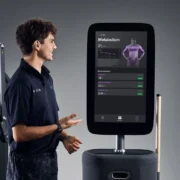P.volve’s ‘Moving During Fertility Treatment’: A Groundbreaking Exercise Program for Women Going Through Egg Stimulation and Retrieval

P.volve, the functional fitness company, is rounding out their mission to support women through every stage of their lives with the “Moving During Fertility Treatment” series
With one in eight women requiring assisted reproduction, P.volve launched the “Moving During Fertility Treatment” series in partnership with Spring Fertility and P.volve’s Clinical Advisory Broad member and reproductive endocrinologist, Dr. Shannon DeVore. The P.volve series addresses misconceptions around fertility and fitness, and provides women with solutions to keep them moving during such a trying time period. Athletech News (ATN) spoke with Rachel Katzman, founder of P.volve, and lead trainer Maeve McEwen, about the series launch.
ATN: What was the inspiration behind the series launch?
RK: The P.volve Method in a lot of ways has been a reflection of my own personal evolution and health journey. The Method started with my diagnosis of Scoliosis that required me to seek an alternative to high impact workouts, which is how I first learned about functional fitness. When I was diagnosed with Lyme Disease and my body was breaking down, we created a suite of Recovery and light stretching content that can meet women who, like me, needed something gentle due to a diagnosis or condition, but didn’t want to give up their movement practice entirely. Most recently, I found myself in another stage of my health journey as I began the process of freezing my eggs. As I learned more about the process, I was struck by what a toll it can take on a woman’s body. But movement is my medicine. It’s my happy place. My ability to move my body every day is what keeps me sane and I know a lot of women out there are like that too. I wanted to make this program because I wanted to have this program for myself and the countless other women out there who, like me, crave daily movement for all of the physical and mental benefits it provides.
ATN: What was the process behind actually creating the movements in the series?
MM: As with many of our specialized series, there were weeks spent researching and learning from the reproductive endocrinologists and team at Spring Fertility before the actual workouts were created. We organized the series into three phases – the Early Treatment Phase (days 1-5), the Ovarian Stimulation Phase (day 6-trigger shot), and the Post-Retrieval Phase – based off the overall timing of an ovarian stimulation process and the physiological changes that happen throughout. The trainers then created the workouts and continually workshopped and edited the movements based off feedback from the doctors.
The movements in these workouts are unique in that we were extremely mindful to avoid twisting, jumping, and excessive movements of the pelvis to lessen the risk of ovarian torsion. The majority of the movements are performed standing at a slow and steady tempo and with a stable base of support.
ATN: Why do you think this series is among the first workout series for women going through the egg stimulation and retrieval process?
MM: There are a lot of common workout moves like planks, leg lifts and some mat sequences that may be best to avoid during ovarian stimulation, therefore a lot of time and consideration was given to every single movement within these workouts.
ATN: What is the long-term mission behind this partnership, and are there any plans to expand the partnership?
RK: This program is a meaningful part of our overall mission to support women with movement throughout the many chapters they undergo throughout their lifetime. It’s a perfect complement to our other Women’s Health content such as Phase & Function, a workout and nutrition program designed to sync with your menstrual cycle, our pregnancy & post-partum content, pelvic floor content, and our recently launched Menopause Series. Our partnership with Spring Fertility has been so well received and we think we’ve only just scratched the surface on all of the amazing opportunities there are to support women’s movement journeys through every stage of their lives.



